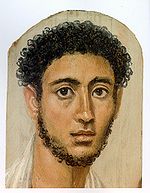Faiyum
Faiyum (Arabic: الفيوم; Coptic: 'Ⲫⲓⲟⲙ) is a city in Middle Egypt and the capital of the Faiyum Governorate. It is located 130 Km southwest of Cairo and occupies part of the ancient site of Crocodilopolis. Its name in English is also spelled as Fayum, Fayoum, Al Fayyum or El Faiyūm. It was formerly named Madīnet el Faiyūm (Arabic for the city of Faiyum).
The name Faiyum (and its spelling variations) may also refer to the Faiyum Oasis, although it is commonly used by Egyptians today to refer to the city.[1][2]
Etymology
| |||||||
| pA-y-m (Faiyum) in hieroglyphs | |||||||
|---|---|---|---|---|---|---|---|
The modern name of the city comes from Coptic 'Ⲫⲓⲟⲙ /Ⲡⲉⲓⲟⲙ efiom/peiom (whence the proper name Ⲡⲁⲓⲟⲙ payoum), meaning the Sea or the Lake, which in turn comes from late Egyptian pA y-m of the same meaning, a reference to the nearby Lake Moeris.
Modern city
Faiyum has several large bazaars, mosques, [3] baths and a much-frequented weekly market. The canal called Bahr Yussef runs through the city, its banks lined with houses. There are two bridges over the river: one of three arches, which carries the main street and bazaar, and one of two arches, over which is built the Qaitbay mosque. Mounds north of the city mark the site of Arsinoe, known to the ancient Greeks as Crocodilopolis, where in ancient times the sacred crocodile kept in Lake Moeris was worshipped. [4]
Faiyum mummy portraits

Faiyum is the source of some famous death masks or mummy portraits painted during the Roman occupation of the area. The Egyptians continued their practice of burying their dead, despite the Roman preference for cremation. While under the control of the Roman Empire, Egyptian death masks were painted on wood in a pigmented wax technique called encaustic—the Faiyum mummy portraits represent this technique.[5]
See also
- Crocodilopolis
- Faiyum mummy portraits
- Faiyum Governorate
- Lake Moeris
- Bahr Yussef
- Roman Egypt
- Phiomia (an extinct relative of the elephant, named after Faiyum)
References
External links
- Falling Rain Genomics, Inc. "Geographical information on Al Fayyum, Egypt". Retrieved 2008-03-29.



